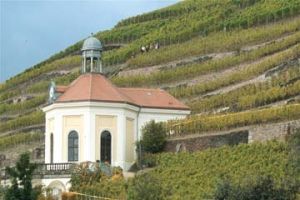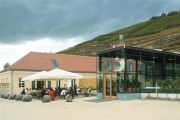 |
 |
Saxony’s wine are back |
 |
 |

|
 Château Wackerbarth © T.Joly Château Wackerbarth © T.Joly

|
Near Dresden, Saxony’s vineyards have undergone a revolution of their own since the end of the Communist era. Several tourist itineraries allow one to discover excellent wines and beautiful countryside where vineyards cling to the slopes of the Elbe.
[ Practical ]
– Getting there
Bus and trains from Dresden and Meissen
- Wineries
www.weinstube-lehmann.de
www.weinterrassen.de
www.scloss-proschwitz.de
www.schloss-wackerbarth.de
- Tourism Association of the Saxon Elbland
http://cms.elbland.de/opencms/
opencms/elbland.de/en/ch_home/
- Pedestrian and cycling paths
www.saechsischer-weinwanderweg.de/
For about 50 km, from Pirna to Diesbar-Seusslitz via Dresden, the Elbe valley is spotted with vines that date back almost 900 years. Planted on small terraces or on slopes of up to 60 degrees, this is Saxony’s wine producing region. The most northern and the smallest in Germany with only 450 hectares.
 White, red and sparkling wines White, red and sparkling wines
Less than the 1 500 hectares cultivated in the 18th century, but more than under Communist rule when common ownership of the means of production and of some estates had left the vineyards in a bad state. Maybe that’s why they are relatively unknown even if today they are again producing quality wines. Mainly sparkling and white ones. Riesling, muller-thurgau, pinot gris, pinot blanc, traminer,… Nevertheless, excellent reds are also produced, particularly from pinot noir. To be convinced of that, just taste the one made by Schloss Proschwitz. The wines range in price from 7 to 15 € a bottle. Sometimes more when it comes to late harvested ones and ice wines. Since the fall of the Berlin Wall changes have been numerous. 130 hectares of vines have been planted. Private winemakers have appeared on the scene. Equipment in the cellars has been modernised and cutting edge wine making techniques have been introduced.

 Schloss Wackerbarth © T.Joly Schloss Wackerbarth © T.Joly
|
One thing that hasn’t changed: the region is still divided into numerous small vineyards. There are some 2500 growers, of whom 1800 representing 164 hectares are members of the Meissen cooperative, once the only estate allowed to make still wines and still the main producer of the region. Its cellar has been modernised and is now open to visitors. This evolution is even more obvious at Schloss Wackerbarth, in Radebeul, which in Communist times specialised in making sparkling wines. Bought by the Saxony Bank for Investment, on behalf of the Saxon State, who invested 20 million € in it, it widened its production to all wines and now looks like an American or Australian winery. Modern looking cellar with up to date equipment, fee-paying guided tours, a restaurant, a picnic area and a large and luminous shop selling wines, gift and books. Everything has been designed and thought out in order to welcome visitors.

 Richter Restaurant © T.Joly Richter Restaurant © T.Joly
|
 Wineries open to visitors Wineries open to visitors
Without going as far, the majority of the private winemakers have also become more tourist friendly. Not just by opening theirs cellars to visitors, but also by offering other services. Schloss Proschwitz Prince “Zur Lippe”, the largest of them with 51 hectares, rents rooms and villas. So too does Lehmann Seusslitzer’s winery, in Diesbar-Seusslitz, which in addition has a restaurant. You can also eat at Bernd Kämpfe’s, near Meissen. Bernd only owns 2000 square metres of vines and doesn’t bottle his wine which is sold in jugs to enjoy on a terrace overlooks the Elbe river. In the same town, the owners of the Vincenz Richter winery also manage a gastronomic restaurant bearing the same name. Located in an historic building, it is a great showcase for their wines.
Moreover, local tourist offices and winemakers have installed a pedestrian path, a cycle route and a road which all traverse the wine-producing area, winding past vineyards, baroque castles, view points over the Elbe, picturesque villages and wineries. A perfect complement to a visit to Dresden and the best way to discover these wines, of which 90 % are sold in Saxony. Everywhere else, and especially outside of Germany, it is difficult to find them except over the internet.
May 18, 2009
Thierry Joly 

|
|
 |

|
 |



